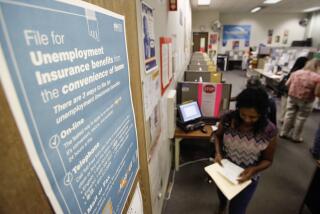Fewer California homeowners received default notices in first quarter
California’s foreclosure crisis eased significantly during the first three months of the year, with lenders pushing the lowest number of homeowners into the formal repossession process since just before the start of the credit crunch.
Banks filed 68,239 notices of default on California residents during the first quarter, San Diego research firm DataQuick Information Systems Inc. said Tuesday. Such notices mark the start of foreclosure, and borrowers receiving such notices during the first quarter were on average six months behind on their payments.
That first-quarter tally represents a 2.2% decline from the previous quarter and a 15.8% drop from the same time in 2010, DataQuick said.
The drop was an indication that the worst of the foreclosure mess is probably over and a much-feared second wave of bank-owned properties is unlikely, analysts said. Instead, foreclosures will probably remain a considerable part of the California market for years as the mortgage industry and government officials continue to sort through the aftermath of the bust.
“It is pretty clear that the worst of the crisis is behind us, but there is a lot of cleaning up to do,” said Christopher Thornberg, principal of Beacon Economics. “The earthquake is over, and now you have to start rebuilding.”
Some of the first-quarter decline was probably a result of lenders’ slowing down home seizures in response to increased scrutiny from their overseers, experts said.
Federal banking regulators last week ordered the nation’s biggest banks to overhaul their procedures and compensate borrowers, citing “pervasive” misconduct in the way they took back homes. A wider-ranging investigation into foreclosure practices conducted by a coalition of state attorneys general and other federal agencies continues.
Banks did step up the number of homes they took back from California borrowers who were already ensnared in foreclosure. The number of first-quarter home repossessions increased 21.5% over the previous quarter and 0.5% from the first quarter of 2010, with a total of 43,052 trustee deeds filed in county offices.
The number of California home repossessions peaked in the third quarter of 2008.
“Could these numbers pop back up? Yes,” DataQuick analyst Andrew LePage said. “Lenders have had their hands full with legal and regulatory challenges and a variety of backlogs; these numbers have bounced around for many months, and that is likely to continue.”
Foreclosure trends in Southern California reflected statewide activity. Notices of default filed in the Southland declined 1.3% over the previous quarter and 15.9% from the first quarter of 2010. Bank repossessions were up 21.1% from the previous quarter but down 4.4% from the first quarter of 2010.
Foreclosure activity remained largely concentrated among the state’s less affluent neighborhoods, although pricier neighborhoods saw a slight uptick from the previous quarter.
Mortgages were least likely to go into foreclosure in San Francisco, Marin and San Mateo counties, DataQuick said. Mortgages with the highest likelihood of going into foreclosure were in Tulare, Madera and San Joaquin counties.
ZIP Code areas with median sales prices below $200,000 collectively experienced an average of 10.7 default notices per 1,000 homes, according to an analysis by DataQuick. The median is the point at which half the homes sold for more and half sold for less.
That higher rate compares with an average of 7.9 filings per 1,000 homes in all ZIP Codes statewide and 3.1 filings for every 1,000 homes found in ZIP Codes with median sales prices of $800,000 or more.
The first-quarter total was the lowest since the second quarter of 2007 and just over half the record 135,431 default notices filed during the first three months of 2009. Although 68,239 notices of default were filed, they involved only 66,251 homes because some borrowers had fallen behind on more than one mortgage.
Leo Nordine, a Los Angeles real estate agent who specializes in foreclosures, said the market has experienced a slow and lackluster flow of repossessed homes from banks since last spring, when government tax credits for buyers expired.
“It has been flat as a pancake since then,” Nordine said. “A lot of people are seeing a double dip, but I don’t see that — just a straight line.”
Most of the loans entering foreclosure are also from the last years of the last housing boom, from 2005 through 2007. The median quarter in which these defaulted loans originated was the third quarter of 2006, which has been the case for the last two years, meaning that weak lending standards probably peaked during that period of time, DataQuick said.
The degree to which the foreclosure slowdown in California has to do with regulatory scrutiny and how much the drop can be attributed to changes in the state’s economic landscape is unclear. Experts said both were probably factors.
A significant number of homes in the Golden State are underwater, meaning that more is owed on the properties than they are worth. The unemployment rate remains high at 12%. Experts view both as major contributors to foreclosures.
More to Read
Inside the business of entertainment
The Wide Shot brings you news, analysis and insights on everything from streaming wars to production — and what it all means for the future.
You may occasionally receive promotional content from the Los Angeles Times.










